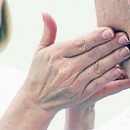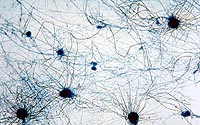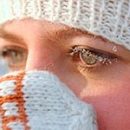Lesion of the skin and internal organs fungi - mycoses. Consider the diseases caused by aspergillosis, madomicosis, sports yield, candidiasis (moniliasis), dermatomycosis, multi-colored (sebugum) dew, seborrheic eczema (seborrheic dermatitis), actinomycosis. Read in this article.
Content
Aspergillez
 Aspergillez – Infectious lesion of the skin, the incomplete sinuses and light or other internal organs caused by mold fungi of the genus Aspergillus, in particular a. Fumigatus. Infection occurs as a result of inhalation of fungal dispute.
Aspergillez – Infectious lesion of the skin, the incomplete sinuses and light or other internal organs caused by mold fungi of the genus Aspergillus, in particular a. Fumigatus. Infection occurs as a result of inhalation of fungal dispute.
The disease is relatively rare, most advantage of agricultural workers and dovers. Ultimate ear tissues are also affected (otomycosis), which is accompanied by itching and pain; When combing, the skin can thicken and acquire gray or black.
A large number of dispute falling into the lungs, causes extensive changes that resemble tuberculosis. Skin Aspergillosis well treats antibiotics. At pulmonary infection, amphotericin is used. However, systemic lesions sometimes lead to death.
Madomicosis
Madomikosis (Madur Stop) – Infectious defeat of the stop (and sometimes other parts of the body) caused by various types of fungi or (half of the cases) bacteria of the births of Nocardia and Actinomyces, forming long branching threads and in this respect with mushrooms.
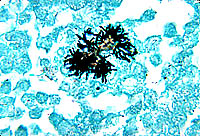 Disease occurs in the tropics and in the south of the USA. Regardless of the type of pathogen around his deployment, swelling appears. In the early stages there are ulcene tumors, but later they disintegrate with the formation of abscesses connected by deep fistulas.
Disease occurs in the tropics and in the south of the USA. Regardless of the type of pathogen around his deployment, swelling appears. In the early stages there are ulcene tumors, but later they disintegrate with the formation of abscesses connected by deep fistulas.
In advanced cases, the skin darkens and is covered with scars that break through the jackets and abscesses filled with fuel mucosa with yellow, red, white or black granules. Leaving the injections, these granules fall into the soil, after which the pathogen can again penetrate the body, usually through the wounds on the foot, but sometimes.
In the absence of foot treatment, they are deformed, and in the end, muscle destruction, tendons and bones occur. The infection caused by Actinomyces is amenable to treatment with Penicillin caused by Nocardia – Sulfanimide drugs. In severe cases, the limb is amputated to prevent secondary bacterial infection, which may be deadly.
Spotrichoz
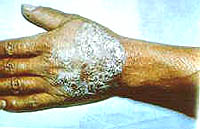 Spotrichoz – Chronic infection affecting mainly skin and surface lymph nodes. Her pathogen – Sporotrichum Schenckii, fungus, which usually strikes plants, in particular Barbaris. The disease is found all over the world, mainly among farmers and gardeners growing Barbaris.
Spotrichoz – Chronic infection affecting mainly skin and surface lymph nodes. Her pathogen – Sporotrichum Schenckii, fungus, which usually strikes plants, in particular Barbaris. The disease is found all over the world, mainly among farmers and gardeners growing Barbaris.
At first, a dense rounded knot appears under the skin, which gradually saves skin. When the surface ulcer is formed, the skin is pinking around it, and then black. Numerous nodules and ulcers appear in the course of lymphatic vessels.
Spiderhosis can develop on mucous membranes, in bones and internal organs, as well as spread throughout the body. With the exception of this latter, disseminated form, the disease is rarely mortal and can be treated with amphotericin.
Candidiasis (moniliasis)
Candidiasis (moniliasis) – Infectious lesion of the skin, nails, mucous membranes or internal organs caused by yeast-like fungus Candida (Monilia) Albicans. Candidiasis occurs all over the world. The causative agent often penetrates the body through the mucous membranes of the mouth and throat and causes the milk – The appearance in the language and mucous membrane of the mouth of cream-white spots, which apply to the palate, almonds and a throat. Since the pathogen is swallowed, in the absence of treatment it is possible to infect light and gastrointestinal tract. Shooting nails (onyhia) or near-gas tissues (paronychy) begins with painful swelling and redness. Nail becomes solid, thick, stressed and often acquires a brownish color. Sometimes there is a detachment of the nail plate from the nail bed, which takes on white or yellow. Candidiasis of the vagina causes symptoms similar to the thrush. With lung damage arises bronchitis or pneumonia, and severe infection can manifest itself as equity pneumonia. If infection in the blood or on the brain shell, the disease always has a fatal outcome. Treatment depends on the place of defeat.
Dermatomicosis
Dermatomikosis is a surface infection of the skin, nails or hair, the most common dermatophytium (the growth of fungi on the dead parts of the skin and its derivatives), as well as.N. Stop athlete (stoppiliation stops) and various other forms of dermatitis, such as multi-colored deprived and seborrheic eczema.
Multicolored (degree) deprived
Multicolored (degree) deprived. This common disease is caused by the fungus PityRosporum Orbiculare (previously called Malassezia Furfur). Only the most outer layer of skin is affected, usually on the torso and lower part of the neck, where rounded brownish-red peeling spots appear, sometimes with a light itch.
Seborine eczema (seborrheic dermatitis)
Seborine eczema (seborrheic dermatitis). Develops on the skin around the sebaceous glands. Manifests itself flat or slightly swelling spots covered with fatty scales (see. Dandruff). Most often Seborine Eclamp causes a yeast-like fungus PityROSPORUM OVALE.
Actinomycosis
Actinomycosis – Traditionally, we are considered one of the mycoses, although this chronic, slowly developing infection causes several types of actinomycetes (most often Actinomyces Israelii), which in modern classification are not related to mushrooms, but to bacteria.
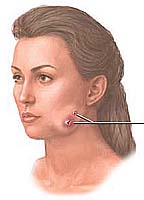 Settled in the tissues of man or animals, they form granules – Clusters of numerous threads formed by their branching cells. Infection occurs when it gets into the respiratory or digestive tract of the granules contained in the liquid of abscesses. Infection can penetrate any part of the body.
Settled in the tissues of man or animals, they form granules – Clusters of numerous threads formed by their branching cells. Infection occurs when it gets into the respiratory or digestive tract of the granules contained in the liquid of abscesses. Infection can penetrate any part of the body.
Initially, an ullane tumors appear (granuloma), which, decaying, turn into deep abscesses with internal moves and cavities. In most cases, the maxillofacial area and neck are affected. The skin on these sites is compacted, loses smoothness and acquires a reddish or purple color. Gradually, foci of infection are opened with the formation of fistula.
In the chest, actinomycetes populate pleura, can germinate the wall of the chest cavity, forming chronic fists, sometimes spread to the esophagus and pericardium (outer heart sheath). This form of the disease often ends with deadly bleeding. Another form leading to death – Aktinomycosis of the abdominal cavity. The first sign is the appearance of a tumor in the field of iliac and rectum. Then the lesion of the liver, spleen and kidneys is developing, and in the absence of treatment – Often also bones and central nervous system. The most effective means of treatment – Penicillin and tetracyclines. The probability of recovery is highest in the event of lesion of the skin and is noticeably reduced as the infection spread.


